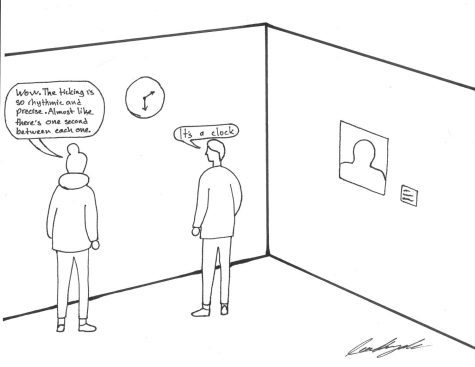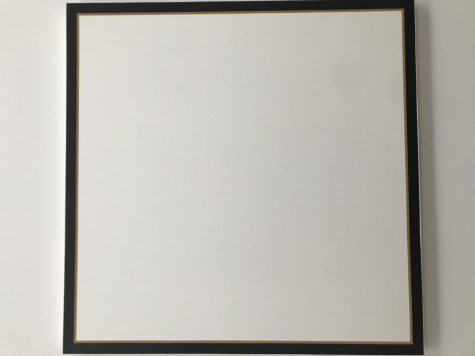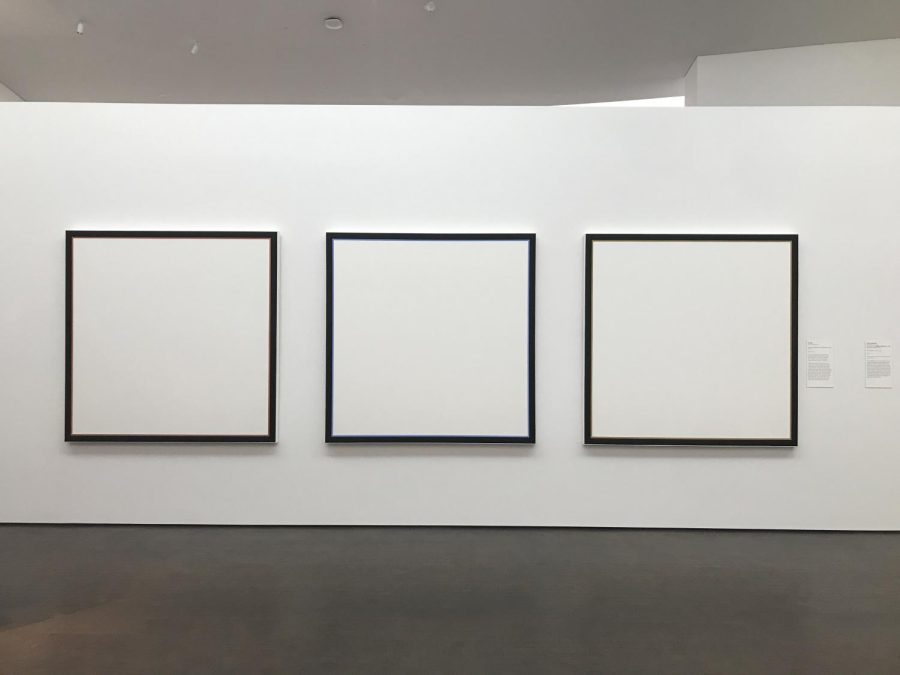Quite the spectacle: Why I think contemporary art is a joke
An art piece by Jo Baer hangs in the Museum of Fine Arts. The piece includes three blank canvases with a trim of color around the edges.
Three. Blank. Canvases.
An art piece by Jo Baer, taking up an entire wall in the Museum of Fine Arts, sits next to the beautiful “Impressionist Landscapes” by Claude Monet. The difference in time, effort, technique and vision is staggering.
When I saw this eyesore, I snickered. All I could think about was the common defense to contemporary art:
“You just didn’t understand it.”
I didn’t like contemporary art because my plebeian brain simply “didn’t understand its true meaning.” If only I were more educated, more in tune with culture, more open minded, more sophisticated – then I, too, could appreciate its beauty.
Yes, how could I miss the nuance in three. Blank. Canvases.
When contemporary art can be literally anything, people should have the right to think art is bad.
From an unmade room to a banana taped to a wall, you either like it or you don’t. But to invalidate someone else’s view on art because “they don’t understand it” is unbefitting. It should not be the audience’s fault for not understanding, or for disliking the piece. Especially when contemporary art is based on a visual and cerebral experience, its “meaning” should be more than subjective nonsense.

This monkey fooled avant garde art experts into thinking it was painted by an expert painter. One critic said “Brassau [the monkey] paints with powerful strokes, but also with clear determination. His brush strokes twist with furious fastidiousness. Pierre is an artist who performs with the delicacy of a ballet dancer.” When a monkey can fool avant garde art experts then you must realize that the meaning of an art piece is subjective.
However, some contemporary art hanging in modern art museums are only displayed because of their monetary, not artistic, value. Investors will donate, or partially donate, over speculated artworks to galleries or museums giving themselves huge tax reductions.
As a result, the laymen seeing these aimless pieces are left trying to figure out the meaning of pointless tax breaks hanging in galleries.

Like the invisible “artwork” that sold for $18,000. It’s nothing. Just empty space. The buyer can see art that no one else can, and that is true in some sense, because no one can see it at all. The whole point of the art piece is that it lives in his imagination. The “meaning” is whatever he wants it to be at any given moment, which strikes surprisingly close to most “meanings” in contemporary art.
Maybe the invisible art does speak to him. It’s completely subjective, after all.
Good for him, but I interpret it as total garbage.
I interpret contemporary in general art as pretentious nonsense. A fraud, created by elitist, eccentric schmucks.
I like art. But when I see nothing on three canvases it makes me like it a little less. Not all contemporary is awful; some are interactive and others are quite clever, but most are a long shot from Leonardo Davinci’s “Mona Lisa.”
Your donation will support the student journalists of Bellaire High School. Your contribution will allow us to purchase equipment and cover our annual website hosting costs.








Anonymous • May 15, 2025 at 3:39 pm
This might be the most agreeable article online. My art teacher once talked about how there was just a hay bale and a lawnmower displayed on the campus of her school as a piece of art. She didn’t get it, and neither would anyone who isn’t hallucinating. But, the only argument others made was that she just didn’t get it. Goes to show how boring the contemporary art movement is.
Elijah Stone • Dec 11, 2024 at 12:52 pm
Thank you for providing this perspective on art! I am a junior in high school in Oklahoma and I am writing an essay over the reflection of art on humanity and the evolution of art values. This may be helpful in doing so, and I completely agree with this article. Thank you,
Dan • Oct 2, 2024 at 1:04 am
I truly believe that there is a hierarchy in art, and although contemporary art can be fun and whimsical, it is on the bottom of the ladder of what human expression produces. The buzz around contemporary art and the sky high prices (which are often a symptom of it being a vehicle for money laundering and tax fraud) is very emperor’s new clothes. It says a lot that one has to be “educated” into thinking that a rotting cows head in a glass box is some kind of human achievement equivalent to the Pieta.
Adam B. • Aug 18, 2024 at 11:13 pm
I had to analyze a video for one of my college classes. The video was so bad, poorly made, jarring, and disturbing, I decided to use a source about why modern art is bad. This article is one of the first ones I found about it. I used it in my paper. Thank you for making this.
John Cooper • Mar 20, 2024 at 12:47 am
The poster is available in the gift shop photocopier.
Lewis • Oct 30, 2023 at 6:54 pm
When I see an art piece that is literally nothing makes more than months of my work, I die a little inside, when I see an art piece that costs one dollar to make, could be made in a few seconds and has literally been eaten and replaced to be able to sell for more than I could make in years I feel like my actions are worth nothing. When I see people say I am just not sophisticated enough to understand it I die a little. And every time I see more and more art pieces like a banana or nothing or literal blank canvases, I feel like nothing, how months or years of my work can be worth things I can find in the trash, I want to die.
Koen Plank • Mar 7, 2023 at 4:48 pm
I think a better title for this piece would be “I Do Not Like This One Specific Piece Because it Feels Low Effort and Elitist” rather than using one outlier to pigeonhole all contemporary artwork as inferior to older art. I think it’s a really big mistake to think whatever is popular and endorsed by the wealthy right now is an indication of what represents the artistic movements of our time.
The art piece you are critiquing cannot be compared to the Mona Lisa or Monet’s paintings because they aren’t trying the same thing. Monet (who was considered avant garde during his life) was attempting to make something beautiful and new that represents the feelings and emotions of a picturesque landscape whereas the piece you are critical of is more of a novelty and likely intended to get a reaction out of an audience. People love the novelty and absurdity of art like this in the moment but it will likely not be considered timeless or be looked back on as something artistically important.
Novelty art has always existed, in 1673 a German composer names Heinrich Biber wrote a piece that was supposed to depict a drunken army by just stacking multiple different songs on top of each other and by both modern and 1600s standards it sounds objectively horrible, but the point wasn’t to sound good it was to be different and get people riled up. Other contemporary art on the other hand is just as skill based and aesthetically significant as the art of 100 years ago. Look at the art of David Hockney, Soyoung L Kim, or Kehinde Wiley for example these are all contemporary artists who have skills on par with Monet or Van Gogh. These are artists who portray their own feelings and emotions with diverse personalities and viewpoints.
Contemporary art is far from a joke in fact I would argue we are living in the greatest time period yet to be an artist. We live in a world where I can see art from halfway across the globe in seconds, where someone can use computers to make beautiful digital art without buying pricey supplies, and artists of any country, religion, or race are valued and can share their art to anyone. Instead of getting upset and preoccupied by “Three. Blank. Canvases.” and playing into what the artist probably wanted, let’s celebrate the unique and diverse world of contemporary art. Rather than attack the art of our time let’s understand why people are making the art they are making and give press to authentic artists, not use meaningless outliers to write off contemporary art as “total garbage” when most modern artists are trying to make creative, skilled, and original art just as the artists of the past we idolize did.
Ian • Apr 17, 2023 at 11:16 pm
I think you missed my point. I’m not using one art piece to generalize an entire genre. I’m using one art piece to exemplify the problems with contemporary art. (I’m also using it as a lead)
The point of the opinion is that my feelings towards contemporary art are valid. And they are valid because contemporary art, for the most part, is entirely subjective. Sure there are some artists that you mentioned whose skills are on par with Van Gogh, but as you say, contemporary art needs to be “understood” which is different from the needs of a Van Gogh painting.
All you need to do when looking at a Van Gogh painting is to look. It is a visual experience, one you can see, one that’s for the most part objective. When you look at contemporary art (not all) it’s different, because the “art” lies in the meaning. Take the invisible artwork that I talked about. What is its meaning?
When you look at the invisible artwork, or rather not look, it’s a completely subjective experience. One that only lives in the eyes of the beholder. You cannot claim that there is a “meaning” to this piece. I use this exaggerated example to emphasize that “meanings” are a cop out, a way to claim that a contemporary art piece is good, as you did. You play into what I wanted by using this cop out as a way to invalidate my views of the art. Which is the entire point of the article.
Granted, some modern art does have meanings that enhance the visual experience, but I am not talking about those. I’m talking about bananas taped to walls, messy rooms, urinals, and other “art” that’s praised, as you claim, as a “novelty.”
You can like it. That’s fine. But I don’t. And I don’t need to “understand it” to have an opinion about it. I don’t need to “celebrate” the “uniqueness” or “diverseness” of contemporary art to see that it is bad.
Anushka Madhavani • Oct 4, 2024 at 5:29 am
Writing an argumentative essay right now against a short piece of writing of choice and I’d seen too many Tiktoks sharing the same sentiments on contemporary art as the author here to not want to argue against them. This wasn’t the article I chose but the one I did was written in 2016, and it had a lot of similar talking points. I’m really glad I found your comment because it helped me formulate some of my arguments – I think your critique on this piece was insightful and I agree with it completely.
The article I used talked about works such as “Petra,” a “a silicone, ultra-realistic statue of a German police woman in riot gear, squatting and taking a piss on the floor.” Of course, op was mad that something like “Petra” was considered ‘high-art.’ and also compared it to impressionist works. lmao. But like you said, these pieces are in media and they are talked about and controversial because that is the artist’s intention. The author of this wrote this whole post, drew a picture to go with it, as well as responded to you with a lengthy comment. It’s been a while since this was posted, so opinions may have changed now but you’re right, the author did probably what the artist wanted. Somehow, those three blank canvases still became thought provoking, anger provoking, and even art provoking! I’d say that’s pretty dam good art. lol
There is so much innovation and new skill being used and discovered – different expressions and mediums and messages being spread through art.. it’s all so exciting! It’s so unfortunate to generalize when we could put our energy and focus into comtemp art in a different way.. but oh well. in our age of media these things are always going to take the stage because things are able to spread hilariously fast and everybody loves to be mad at something
anyway thank u sm for this comment I appreciate the help you unknowingly gave me
Andrew Liu • Feb 23, 2023 at 9:59 am
I agree, a banana on a wall is not art.
Jason Deng • Feb 26, 2023 at 7:13 pm
Brassau the monkey would think otherwise